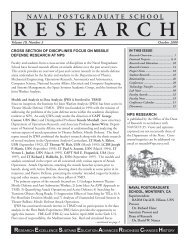Spectral Unmixing Applied to Desert Soils for the - Naval ...
Spectral Unmixing Applied to Desert Soils for the - Naval ...
Spectral Unmixing Applied to Desert Soils for the - Naval ...
You also want an ePaper? Increase the reach of your titles
YUMPU automatically turns print PDFs into web optimized ePapers that Google loves.
A. IMAGERY DERIVED ENDMEMBERS<br />
The initial run of <strong>the</strong> MTMF algorithm was conducted using imagery derived<br />
endmembers <strong>for</strong> <strong>the</strong> purpose of determining if <strong>the</strong> patterns observed were comparable <strong>to</strong><br />
those of <strong>the</strong> collected field spectra. Imagery derived endmembers are obtained from <strong>the</strong><br />
imagery itself and are typically thought <strong>to</strong> yield <strong>the</strong> best results so should provide a good<br />
standard of achievement <strong>for</strong> <strong>the</strong> user supplied endmembers (Kruse and Boardman, 2011).<br />
The MF score verses infeasibility plots of imagery derived endmembers were also<br />
analyzed <strong>to</strong> see how imagery derived endmembers stacked up against user supplied<br />
endmembers (Figure 27). Figure 27, inset C shows a 2D scatter plot of MF versus<br />
infeasibility <strong>for</strong> <strong>the</strong> mean class 1 endmember from <strong>the</strong> f110512t01p00r07 flight and<br />
includes a true color version (Figure 27, inset A) of <strong>the</strong> imagery <strong>for</strong> comparison.<br />
The colored area (Figure 27, inset B) is <strong>the</strong> class created in <strong>the</strong> scatter plot based<br />
on <strong>the</strong> criteria of a high MF score and low infeasibility score, corresponding <strong>to</strong> areas with<br />
high abundances (0.30–0.76) and feasible mixtures with <strong>the</strong> composite background. The<br />
imagery depicted in Figure 27 is from flight f110512t01p00r07 of <strong>the</strong> Newspaper Rock<br />
National His<strong>to</strong>ric Monument area near <strong>the</strong> Needles entrance of Canyonlands National<br />
Park so trails are expected. The average trail can be between 2 and 6 feet depending on<br />
what it is used <strong>for</strong>. With a resolution of 2.9 m per pixel (9.5149 ft), a 0.61 m (2 ft) trail<br />
would represent a maximum of 21%, a 1.22 m (4 ft) trail would be a maximum of 42%,<br />
and a 1.83 m (6 ft) trail would reach a maximum of 63% of <strong>the</strong> pixel. Based on <strong>the</strong><br />
results from endmember 1 and o<strong>the</strong>r imagery derived endmembers, and <strong>the</strong> maximum<br />
possibilities <strong>for</strong> trails, which would be <strong>the</strong> largest target <strong>to</strong> identify, <strong>the</strong> goal <strong>for</strong> a match<br />
of user supplied endmembers will be between 15–60 %. Mainly <strong>the</strong> 15–60% range is<br />
based on <strong>the</strong> fact that while achievable higher percentages are possible with imagery<br />
derived endmembers, user supplied endmembers utilized <strong>for</strong> imagery are from<br />
geographically different areas. There<strong>for</strong>e, <strong>the</strong> expectation is that <strong>the</strong> user supplied<br />
endmembers will produce less accurate results.<br />
54
















